Successfully navigating an Equal Employment Opportunity Commission (EEOC) investigation requires more than good intentions — it takes a clear strategy and solid understanding of the process. And with all the new EEOC changes 2025 brings, it’s no surprise if you’re feeling overwhelmed.
This guide is designed to arm your organization with everything it needs to successfully tackle EEOC investigations. With the right approach, consistent processes and smart issue management, your organization can respond to complaints confidently. Yes, it really is that important to have a clear strategy for handling EEOC investigations because discrimination and microaggressions are still widespread in the workplace.
Since the start of 2023, nearly 1 in 3 employees have reported experiencing discrimination (28%), and microaggressions aren’t far behind (27%). These aren’t just isolated incidents — they reflect deeper patterns that, if left unaddressed, can lead to serious consequences.
So, what’s the best way to handle an EEOC investigation? For starters, let’s break down how the process works — and how you can stay ahead of it.
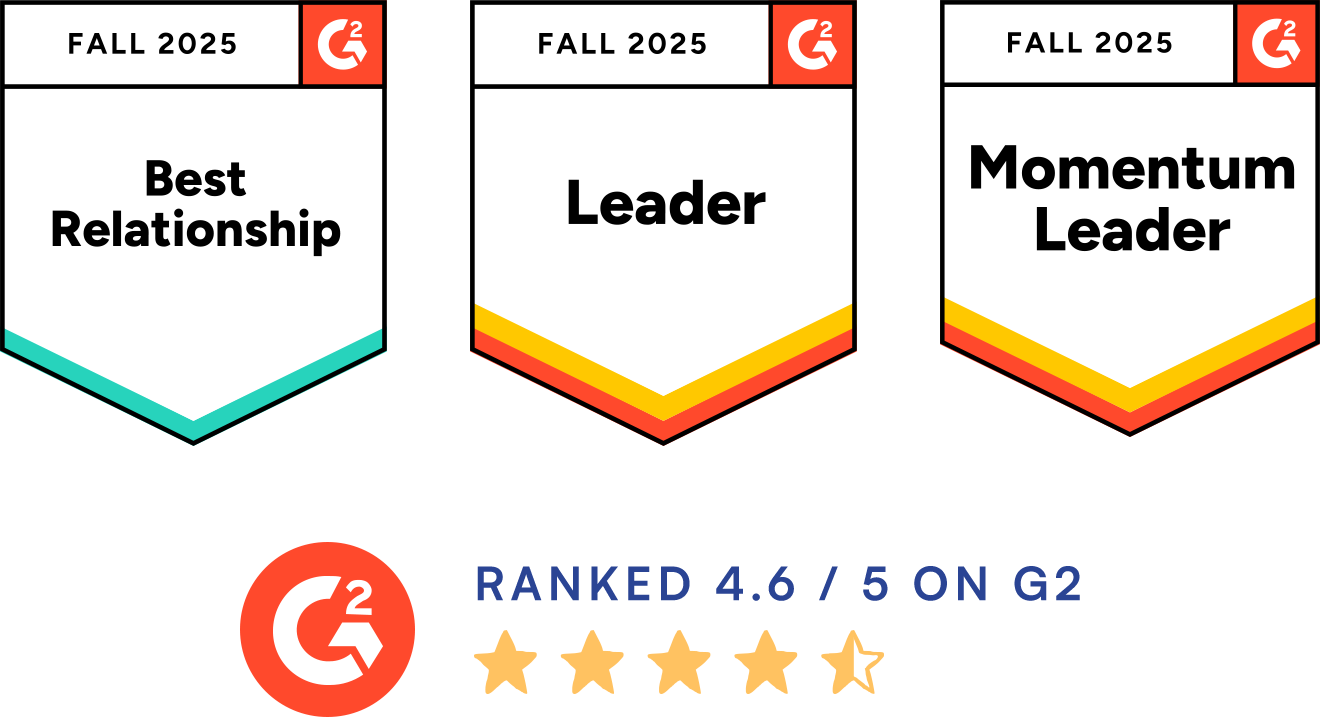
What Does the EEOC Investigate?
Under United States federal law, the EEOC enforces regulations against workplace discrimination based on:
- Race
- Color
- Religion
- Sex
- National origin
Employee complaints regarding job discrimination, wrongful termination or whistleblowing can also lead to a comprehensive EEOC investigation. Your organization can also become the focus of an EEOC inquiry without a specific employee complaint because it will occasionally address concerns proactively.
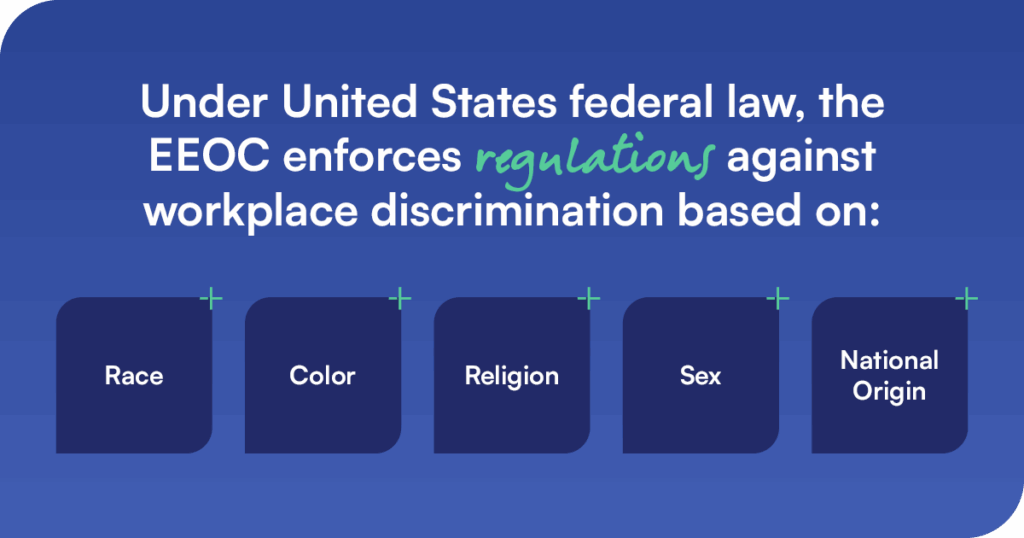
What Happens During an EEOC Investigation?
An EEOC investigation is a comprehensive review to assess if your business has violated anti-discrimination laws. We’ll go into further detail about the process later, but here’s a quick breakdown of what to expect:
- Gathering Information
- Interviewing Witnesses
- Reviewing Workplace Practices and Policies
By staying current with EEOC investigation guidelines, your organization is in a better place to stay compliant and proactively address any issues that arise.
How Long Do EEOC Investigations Last?
The EEOC aims to resolve charges within 180 days, but the reality is that investigations are complicated and timelines are unpredictable.
The complexity of the case is the biggest factor in determining the duration of an investigation. Straightforward cases might wrap up in a few months, while intricate ones can extend a year or more.
Other factors that influence the length of an EEOC investigation include:
- The details of the complaint
- The quantity of evidence needed
- The availability of witnesses
- The caseload of investigators
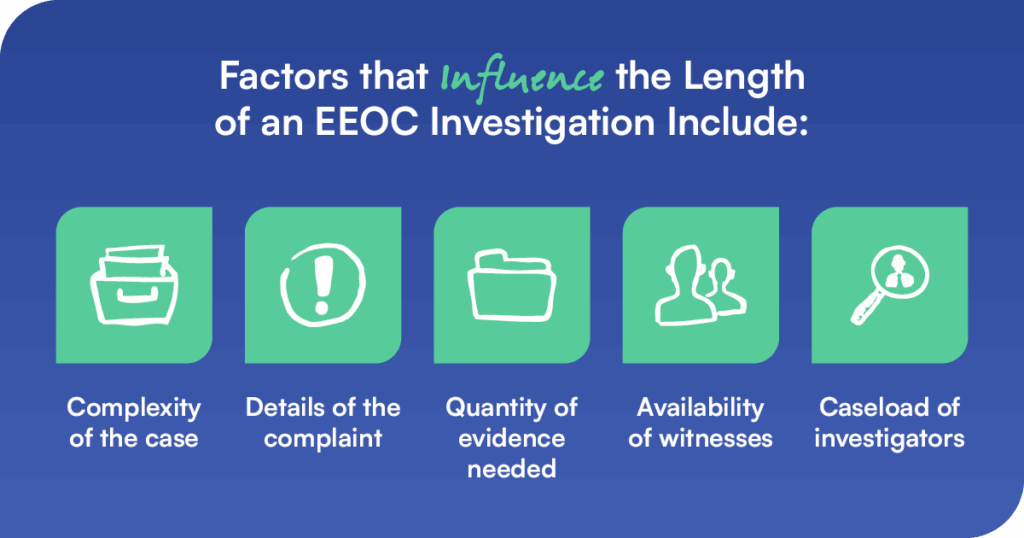
Breaking Down the EEOC Investigation Process
While timelines can vary, the EEOC investigation process is typically consistent for most claims. Here’s what to expect:
1. Filing a Charge
An employee files a charge of discrimination to kick off an EEOC investigation. This charge must outline specific violations of anti-discrimination laws, detail the nature of the alleged discrimination and identify the parties involved.
Employees can submit their charges online, by mail or in person at an EEOC office. Once submitted, this charge sparks the formal EEOC investigation process, prompting the team to review the claim and determine next steps.
2. Notification and Acknowledgement
So, an employee filed a complaint. Now what?
Expect to hear from the EEOC within ten days. When you do, you’ll also receive a copy of the charge. At that point, begin to prepare your response and gather necessary documentation or evidence connected to the case.
(Psst: This is why a centralized HR case management system is so critical. Without it, documentation can be a real hassle to track down — plus, you can end up missing some important pieces of the puzzle.)
3. Gathering Information and Conducting Witness Interviews
During the third phase of the EEOC investigation process, the agency requests documentation from your team, the employer. The EEOC may also conduct interviews with employees to gather additional information about the allegations.
This step enables the agency to collect both tangible evidence and firsthand accounts from onlookers. With this evidence, the EEOC is better equipped to establish the facts of the case.
Reminder: the EEOC may request both parties to submit position statements and responses to facilitate the fact-finding process.
4. Analyzing Evidence
Once the EEOC has gathered the necessary information, it analyzes the evidence to deduct whether or not discrimination has occurred.
The agency will review:
- Documentation
- Interview notes
- Gathered evidence
Its goal is to impartially determine if the employer’s actions violate federal anti-discrimination laws.
5. Determining the Outcome
Once the review wraps up, the EEOC concludes investigations by determining and sharing the outcome. If it detects discrimination, the EEOC will attempt to reach a settlement with the organization.
If discrimination was not found, or if the agency was unable to reach a decision, the EEOC closes the case and may issue a “Right to Sue” letter to the complainant. This permits them to file a lawsuit in federal court about the allegation within 90 days.
6. (Optional) Mediation
Not all cases end in court or with a settlement — mediation is another option during the EEOC investigation process.
The EEOC refers to mediation as a voluntary alternative dispute resolution (ADR). It’s also considered less formal than the traditional investigative and litigation processes.
If the employee decides to go the mediation route, a mediator will help the involved parties reach a resolution. The goal is a faster, less resource-intensive path to settlement.
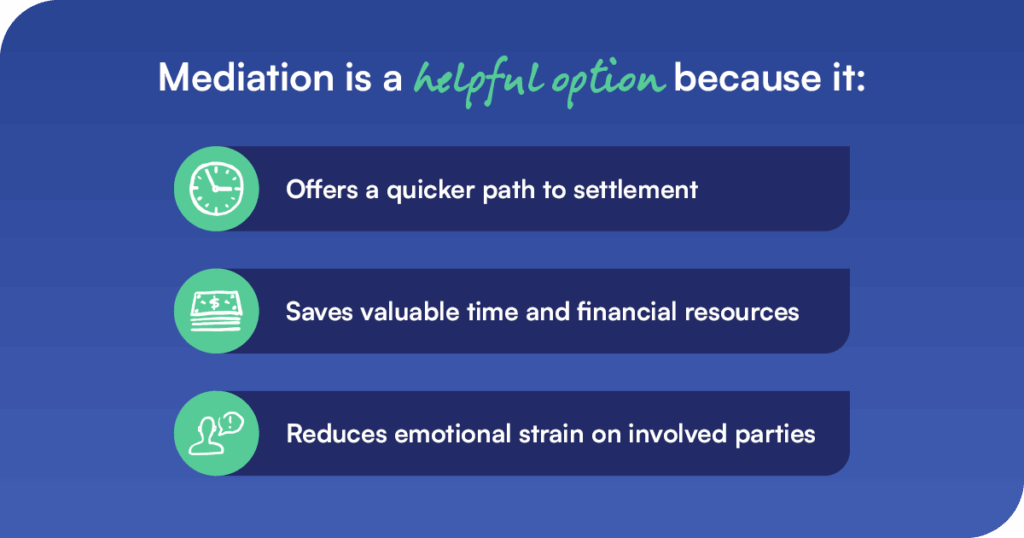
Remember: with mediation, the mediator isn’t there to determine who’s right or wrong. The mediator’s goal is purely centered around reconciling differences.
Mediation is a helpful option because it:
- Offers a quicker path to settlement
- Saves valuable time and financial resources
- Reduces the emotional strain on involved parties
7. Litigation
Sometimes, mediation isn’t an option and your case needs to go to court.
According to the EEOC, “The EEOC has the authority to sue nongovernmental employers with 15 or more employees for violations of Title VII of the Civil Rights Act of 1964 (Title VII), the Americans with Disabilities Act (ADA), the Genetic Information Nondiscrimination Act (GINA), and the Pregnant Workers Fairness Act (PWFA).”
However, not every discrimination complaint leads to litigation. The EEOC’s resources are limited, so the General Counsel evaluates whether to pursue a case based on:
- The nature of the violation
- The concerns raised
- The potential impact of the lawsuit on broader anti-discrimination efforts

Best Practices for Responding to an EEOC Investigation
There’s no question about it: the EEOC investigation process is overwhelming, time-intensive and costly. However, there are ways to make it easier to manage. Here’s how:
Take EEOC Investigations Seriously
Allegations of discrimination are serious and must be treated as such. Show your organization’s commitment to a discrimination-free workplace by addressing concerns swiftly and professionally. That includes keeping the lines of communication open with your employees.
Assign a Team to Handle the Investigation
To handle an EEOC investigation effectively, assemble a dedicated team that knows the ropes.
Be sure to loop in your:
- HR leaders
- Employee relations experts
- Legal counsel
- Key stakeholders
Keeping these stakeholders in the loop ensures a streamlined, consistent process.
Review and Gather Relevant Documentation
As soon as you learn your organization is the subject of an EEOC investigation, pull together:
- Policies
- Procedures
- Employee records
- Information from previous complaints or investigations
As a general rule, the more information, the better. These details will prove helpful when you respond to the EEOC’S inquiry.
Cooperate with the EEOC
This one might seem obvious, but we think it’s worth mentioning. When the EEOC asks for details, get them to the agency in a timely manner. And when the investigator asks questions, provide as much detail as you have. Failure to cooperate may give the agency reasonable cause for a discrimination claim, and that could mean further legal action.
Seek Legal Counsel
If you end up involved in an EEOC investigation, we suggest you reach out to an employment attorney who has experience working on EEOC investigations.
By doing so, your team will be able to navigate the process better and protect the organization’s interests. Best of all, the attorney can provide strategy advice, help prepare documentation and even represent your company during the investigation — reducing lift on your team.
How to Reduce the Risk of Future EEOC Investigations
You’ve probably heard the saying, “An ounce of prevention is worth a pound of cure.” This is especially true when it comes to EEOC investigations.
Implementing the right strategies can significantly reduce the likelihood of receiving an EEOC claim in the future. Most importantly, these measures will help you create a workplace that truly feels welcoming and accepting for all employees.
Review Company Policies and Update as Necessary
At a foundational level, your organization needs to comply with federal and state employment laws. To make sure it does, schedule reviews of company policies and procedures.
Pro tip: You’ll want to do this on a regular basis. This is especially important with the onslaught of EEOC changes in 2025.
Train Managers and Supervisors on Policy Enforcement
Your managers are your first line of defense. That’s why it’s imperative you make sure your people leaders understand how to cultivate a fair, consistent work environment.
HR Acuity helps better equip your managers with the confidence and resources they need to tackle day-to-day employee issues. It also ensures they have direct access to documentation, procedures and other key employee documents.
Foster an Inclusive Work Environment
Despite what you may believe from 2025’s EEOC changes, DEI is not illegal. Fostering an inclusive work environment where all employees feel safe has always been the right thing to do — and it still is.
Encourage your employees to report any concerns they may have so you can investigate and resolve them promptly — and without EEOC involvement.
Offer Anonymous Reporting
Employees often hesitate to share concerns due to fear of retaliation or simply feeling uncomfortable. But 72% of employees feel comfortable sharing an issue when there’s an anonymous reporting tool available, according to our Workplace Harassment & Employee Misconduct Study.
By introducing an anonymous speak-up tool, you build a culture of transparency and trust. Ultimately, this proactive step can help you avoid costly EEOC investigations and create a safer workplace for your entire team.
HR Acuity’s anonymous speak-up reporting hotline provides your team with a confidential, secure way to report concerns without fear of retaliation. Our compliance hotline integrates seamlessly into your case management platform, empowering your team to keep everything in one, easy-to-access location. Plus, it’s accessible in more than 50 countries, featuring 24/7 toll-free support in up to 35 languages.
Identify Hotspots and Patterns with Employee Relations Data
Using employee relations data, you can pinpoint patterns and trends in complaints, enabling you to tackle areas in need of improvement proactively.
For example, you’ll be able to flag if one team has a spike in discrimination complaints, or if a certain office location is reporting more harassment claims than others. By leveraging this data, you gain insight into your organization and can address critical issues before they escalate.
Prioritize DEI During the Hiring Process
Provide equal employment opportunities to individuals with criminal records to demonstrate your organization’s commitment to fair and equitable hiring practices.
Implement and Maintain Diversity Equity and Inclusion Initiatives
Foster a diverse workforce and an inclusive culture through initiatives like unconscious bias training and mentorship programs. Once you’ve launched your DEI initiatives, make it a priority to maintain them. DEI should be a year-round commitment — not just a box to check during certain months.
After the EEOC wraps up an investigation, take the opportunity to learn and grow. Analyze the findings and implement meaningful changes to minimize the risk of similar issues in the future.

2025 EEOC Changes and Their Impact on Investigations
This year has brought unprecedented change to the EEOC, largely due to the Trump administration’s sweeping modifications of existing regulations, including the following actions:
- Removed the EEOC’s General Counsel, Karla Gilbride, and appointed Andrew Rogers as the replacement.
- Appointed Andrea Lucas, an outspoken opponent of DEI, as the chair of the EEOC.
- Removed two EEOC Commissioners before their terms ended.
Trump’s EEOC-related changes have primarily been centered around the concepts of gender ideology and DEI-related discrimination.
So, what do these EEOC changes mean for organizations on a day-to-day level?
The reality is: we don’t know yet. What we do know is that we’re probably less likely to see ‘traditional’ EEOC investigations during Trump’s tenure — such as those related to color or race. We may see an increase in issues connected to Trump’s beliefs on gender ideology and DEI-related discrimination.
What To Do as an Employee Relations Professional Facing EEOC Changes in 2025
With the EEOC changes 2025 brings, it’s more important than ever for employee relations leaders to do the right thing — and to stay up to date with the news.
Here’s how to successfully tackle the 2025 EEOC changes as seamlessly as possible:
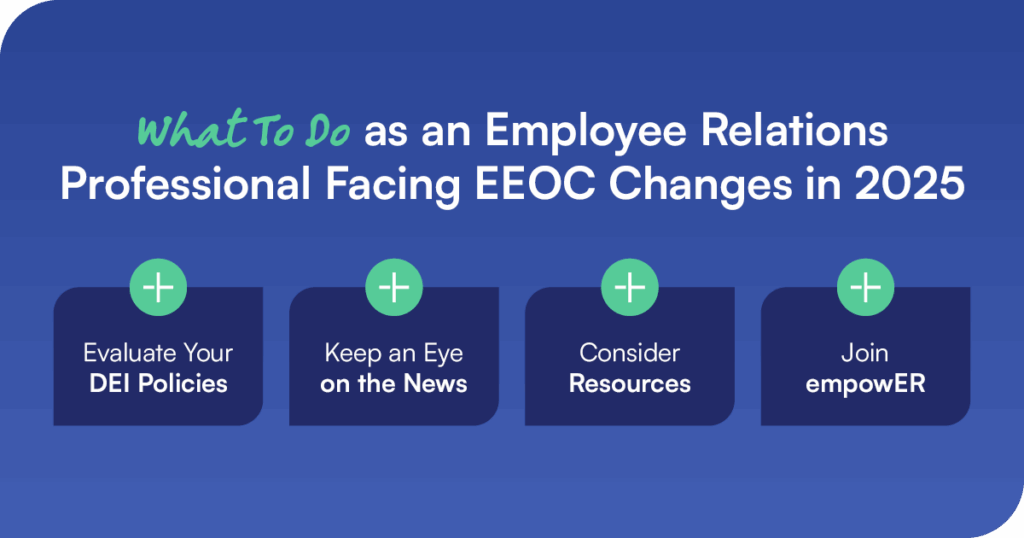
1. Evaluate Your DEI Policies
Whether your company is saying goodbye to its DEI efforts (which we strongly advise against) or strengthening its commitment, now’s a good time to evaluate your DEI policies.
With the current administration’s views on it, you might need to slightly modify the wording of your company procedures.
“Businesses need to come up with a way to talk about DEI without calling it DEI because I think there’s been some damage done to the branding of what DEI is,” shared Jonathan Hyman of Wickens Herzer Panza.
“We still need to focus on the ideas of diversity and equity — so when I say focus more on inclusion and belonging, and less on diversity and equity, I don’t want you to think I’m saying DEI should be all about inclusion. [But] if businesses can shift their focus more towards making people feel included once they’re within the business, businesses can keep themselves off the government’s radar and help move this mission forward.”
For instance, if your organization explicitly calls out gender ideology or race, you may be getting a notice from the EEOC sooner than later.
2. Consider Your Resources
Even if you — or your organization at large — don’t agree with the Trump administration’s beliefs, employers in the U.S. are required by law to have certain posters from the EEOC up and visible.
It’s extremely likely the agency will modify key resources to match its beliefs, like the “Know Your Rights” poster. If it does, and you don’t update yours, you may receive a fine.
3. Keep an Eye on the News
Every day, there’s a new headline about the EEOC changes 2025 and the Trump administration brings. As an employee relations leader, it’s your job to stay abreast of what’s going on in the media. This empowers you to act proactively and stay out of trouble with the EEOC. Take a few minutes each day to peruse the news for any updates.
4. Collaborate with Peers
Let’s address the elephant in the room: it’s a really weird time to be an employee relations leader. The great news is that you don’t have to navigate this period of EEOC changes alone. By joining empowER, HR Acuity’s community for employee relations and HR leaders, you can talk through these updates with other folks that are facing the same questions you are. (Plus, it’s free to join!)
Employee Relations Software and EEOC Investigations
It takes the right tools to address EEOC investigations effectively. With HR Acuity’s purpose-built, industry-leading technology, you’ll have the right resources at your fingertips to tackle any employee relations issue or investigation that comes across your desk.
Ready to discover how HR Acuity can empower your team to create a fair, discrimination-free workplace? Schedule a Curiosity Tour with our expert team today!



